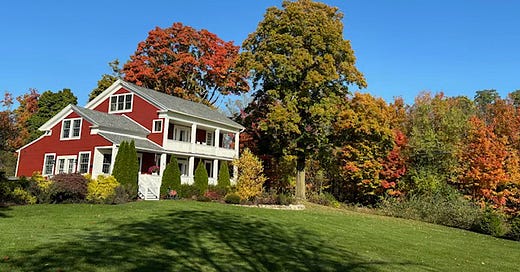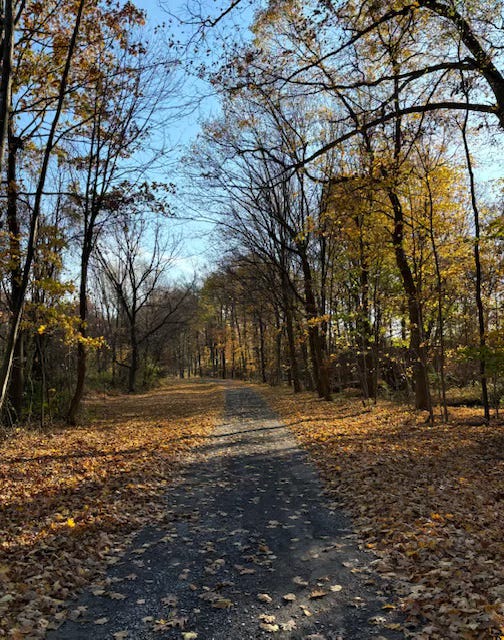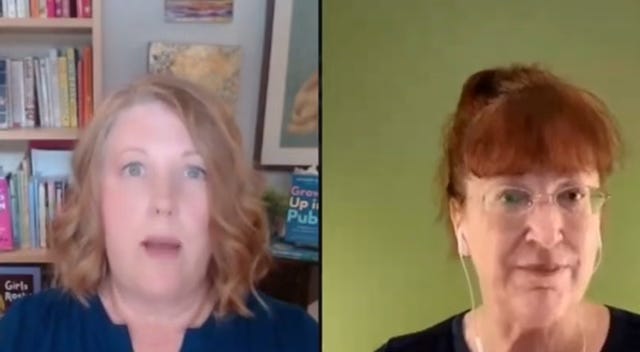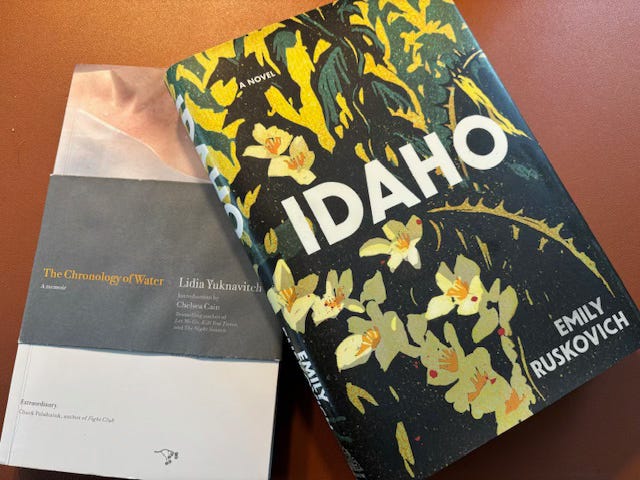This is It Takes A Village, a monthly conversation about reading, writing, and community-building.
Welcome, lovely subscribers, lurkers, readers, and writers! So happy to have you here! A special welcome to our new subscribers—we’re so glad you’ve joined our village.
In this issue:
On the Farm
Writer’s Life
Book of the Month
Bonus: Writing Prompt
On The Farm
South of our pond, beyond the poplars and meadow, lies a twelve-acre field, most often planted with corn. The farmer who leases that land often plants and plows at night. Like a lot of farmers around here, he has a day job, and can’t get to his field until he has to use a headlight on his tractor, a ghostly white glow we see in the distance traversing back and forth in the night.
South and east of that field, deep woods conceal a herd of deer, foxes, coyotes, and a winding stream that occasionally has enough water to quench their thirst. In the middle of those woods lies a deep gorge, carved by ice and water around 20,000 years ago. The gorge is so deep, wooded, and dark, that, standing at its edge even on a bright summer day, it’s hard to see the bottom. If there happens to be water in the stream, a long, multi-tiered waterfall flows from the stream, over layers of rock, down, down, down into the gorge, eventually finding Lake Cayuga.
A dirt and gravel, one-lane road winds past the field and into those woods. The road is named for Nicholas Bainbridge, the man who built our house in 1828. The sign says “Bainbridge Beach Road—Private.” I walk the dogs there sometimes. Though it’s private, and eventually leads to houses on the other side of the woods, no one seems to care that we walk there. I keep the dogs on leashes long enough to let the Australian shepherd dip into the stream bed and bound through the high grasses. It’s a pretty walk, in dappled shade. Usually, the sun is setting just up the hill, igniting color at the tops of the trees. We can look back toward our property just before we enter the woods and the view of our farmhouse with the lake in the background always moves me and reminds me how fortunate we are to live here.
More often than not, though, I get an odd feeling as I enter those woods. My skin seems to sense something, and not just the fifteen-degree temperature drop. Can a road be haunted the way a house can be haunted? Is there even such a thing as haunting?
About a month after we moved into our 200-year-old farmhouse, a neighbor stopped me on the street to inform me our house is in some directory of haunted places. I’ve never been able to verify that, and have never encountered anything unusual, though my sister-in-law, who has stayed with us, says she’s heard strange noises in the night.
The woods, though, are a different story. Walking there, I warily squint into their darkness. A deer can appear out of nowhere and leap over the narrow road so soundlessly, the dogs, with their noses to the ground, fail to notice. It’s as if the deer doesn’t really exist. In winter, when the absence of leaves reveals it, I recognize the remains of a horse-drawn wagon, one wheel off kilter, leaning against a tree on the far side of the gorge from where we stand. I imaging Nicholas Bainbridge there, cursing his poor luck, or even meeting his maker in an accident in what was once his field. The legend around here is that he complained about his cows occasionally falling over the edge of the gorge, and the impossibility of building a fence to hold them back. Could he have met the same fate? I’m not the only one who senses a creepiness in those woods. Our beagle, Bella, looks back over her shoulder repeatedly, as if she believes we’re being followed.
Have you ever experienced haunting in a house or elsewhere? Do you know of any haunted roads?
Writer’s Life
In a 2023 interview with Stephenie Harrison, poet and author, Elizabeth Acevedo, said, “I write what haunts me.” I understand this. I’ve written obsessively about my adoption, about the “ghost” family I imagined as a child, the one who birthed me but with whom I didn’t live, the family whose lives went on parallel to mine, but without me. At times, I find it hard to write about anything else. Yet, at the same time, I’m aware of how difficult it could be to publish my memoir, then have talk about the trauma of adoption ceaselessly during the memoir’s promotion.
Allisonn Lane and Allison K Williams
I’m a writer. It’s what I do. I have to write; it comes unbidden. So, I’ve had to grapple with not allowing the obsessions and ghosts to take over. I follow the advice of the two fabulous Allisons in my writing life: Allison K. Williams and Allison Lane. When I expressed to each of them separately that I worried I’d have to write only about adoption to stay “on brand” and that I’d become “the adoptee lady” and nothing else, they each told me it’s okay to write about topics different from my memoir. Their only caveat was that the topics I write about should actually interest me. Allison Lane advised identifying three “containers” of content. With that as my guide, I selected adoption / family, farm life, and writing craft as my three containers—they’re my life! The beauty is, they seem disparate, but aren’t exclusive from one another. When I publish a craft piece in Brevity Blog, such as “What I Learned About Essay Writing by Reading for a Literary Magazine,” more people end up reading one of my essays on adoption, such as this one, “I Could Have Gone to Prison for What I Did to Find My Birth Parents,” in HuffPost. Writing about things aside from my major obsession of adoption and family trauma is one of the ways I take care of myself, as well as attract new readers.
What are your three containers?
Book of the Month
This month, I’m recommending two books that haunt me—each for a different reason. The first is a memoir that has become like a spirit whose voice whispers in my ear. The second is a work of fiction so strange and yet psychologically true, it gripped me when I first read it in 2018 and has never let me go.
If I could be any writer, I would be Lidia Yuknavitch. In her memoir, The Chronology of Water , her deceptively plain prose and conversational voice swim with hard-won revelations. She writes, “You will see you have an underlying tone and plot to your life underneath the one you’ve been told. … Something near tragic, near unbearable, but contained by your irreducible imagination….” Her descriptions of loss, or rather of her physical and emotional responses to loss, are both so strange and so real, they will live in you forever.
The book chronicles her transformation to artist through a journey that includes a difficult childhood, addiction, self-destruction, and ultimately motherhood and survival—a journey that’s ugly and messy and raw and absolutely perfect on the page. It’s a stellar example of how a narrator’s voice builds trust.
Emily Ruskovich’s novel, Idaho, was a Los Angeles Times bestseller, and yet it never got the traction it should have, given its gorgeous prose and compelling story. In it, Ann, whose husband, Wade’s, memory is failing, attempts to piece together the mystery of what happened to Wade’s first wife and their two daughters. Through multiple perspectives, the novel winds through time, exploring the nature of memory and violence.
This book is a particularly good example of how setting informs and augments story and how psychological truth can support the most unexpected consequences.
Bonus: Writing Prompt
The day this issue of It Takes A Village goes live, November 1, is All Saints Day, also known as the Day of the Dead. So, let’s write a ghost story, of sorts.
Make a list of your obsessions. These could be events, people, ideas you want to bring to fruition, things you’ve always wondered about—real or imagined. They can be tragic or goofy or somewhere in between. Let your mind stretch and play.
When you’ve exhausted your list-making, pick one obsession that calls to you.
Now, imagine your obsession lives with you in a house it haunts. What sounds, sights, smells, etc. would your obsession create as it wanders about the house? What would it do? What’s your obsession’s “personality”? Is it meek, hiding around corners? is it knocking things off shelves? How do you imagine taming, befriending, banishing it, or creating some other type of relationship with it? Does it have anything to say to you? Do you have anything to say to it?
I hope you’ll share some of what you get from this exercise in the comments, even if it’s just your list of obsessions.
Thanks for spending time here with me. I truly appreciate it. Feel free to recommend It Takes A Village to other readers and writers and to send along your suggestions, questions, and thoughts.
--Jillian








Thank you for your words and honesty, and for opening my mind to new perspectives. I can write obsessively about my family trauma, adoption and reunion to the point I exhaust myself. Writing about other things that move me is definitely an act of self care. And yes! I would love to be Lidia the writer too 😃
Lovely. And - your brand is your voice! We readers will follow it to any topic!